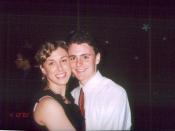Film and cinema are one of the most prominent forms of media and entertainment in today's society. True filmmaking is realized by artistic visionaries who possess the ability to convey and communicate a story through the lens of a camera to the world. Filmmakers with an identifiable, stylistic manner of directing are privileged with the prestigious title of an auteur. Although numerous directors utilize similar cinematic techniques throughout their films, Sydney Pollack is considered a true auteur director due to his extensive use of prolonged circular panning shots, his enduring use of an isolated, naÃÂïve protagonist, and his consistent commentary on social and moral issues.
One of the principal distinguishing indicators that identify a Pollack film are Pollack's extensive use of handheld cameras and lengthy, circular tracking and panning shots. Several examples of this cinematic technique can be noted throughout his films. In Pollack's film, They Shoot Horses, Don't They?, Pollack employs a very long panning shot of the contestants in line, quickly giving just enough information about each character to allow the viewer a gist of each one's personality.
Pollack utilizes a similar shot in the film when the contestants furiously devour food during a break, through which he exploits the same filming scheme as at the beginning of the film, and slowly depicts the steady physical and mental decomposition of the contestants as the marathon progresses. In The Firm, a very clever, symbolic shot of Mitch first entering the boardroom of the Firm, in beginning of the film, not only utilizes an interesting panning shot, it is also used to convey a greater meaning of miniaturization, and Mitch's relative power and significance in comparison to that of the Firm. Several panning shots were also utilized to exemplify the minuscule presence of Mitch in large landscape shots, and interior shots. Finally, in Tootsie, Pollack draws on this technique in several parts of the picture as well, however not as heavily as he normally does in his other movies. In the beginning of the film, Pollack continually tracks Michael at his surprise birthday party, as he socializes with the unacquainted and drunkenly flirts with various women throughout the party. Pollack also employs several handheld tracking shots in almost all of the scenes where Michael is walking down the streets. This, in itself, serves as a recurrent incident in the film conveying the message of loneliness, and idleness. The reoccurring use of extensive circular panning and tracking shots in association with symbolic meaning and representation, is a not uncommon phenomenon in Pollack films, thus marking it as an identifiable indicator of his works.
Pollack's continuous utilization of an alienated, inexperienced central character confined within a lone conflict is yet another compelling indicator of a Pollack picture.
In They Shoot Horses, Don't They?, the character of Robert is a naÃÂïve, isolated, and submissive character whose sheer inexperience and innocence leave him an aimless, and undetermined waste of a life. Obediently taking part in a catastrophically exhausting dance marathon against his will, Robert is continually taken advantage of and manipulated throughout the film. Complying with the forceful demands of his dismal and extremely cynical dance partner Gloria, Robert's naivety leaves him in the awkward position and conflict of wanting to satisfy everyone's needs, for the hope of fulfilling a boyish pursuit of being useful during the difficult times of the Depression. In the movie, The Firm, the character of Mitch is a young, inexperienced, and sheltered man who is plagued with the memories of a disgraceful past which, although loved dearly by his wife Abby, segregates him from rest of the world on a quest to outrun, surpass, and outdistance his shameful history with his achievements. Still, youthful and greatly materialistic, Mitch is immediately attracted to the offer proposed to him by a small Memphis Firm. Eventually this desirous thrust presents Mitch with the gargantuan conflict of himself against the Firm, and in due course Mitch against himself. A final example of Pollack's enduring usage of a secluded, unaware protagonist is the character of Michael in the film Tootsie. An unemployed, insecure and lonely actor whose effervescent passion for acting and all of its ideals leaves him an ill-tempered, disagreeable, melodramatic wreck. Constantly arguing with his agent, bickering with friends, and disagreeing with anyone whose opinion concerning show business conflicts with his own, Michael creates a barrier between himself and society. Eventually resorting to any method of getting employed and becoming even remotely famous, Michael eventually creates an enormous conflict between himself, the world and the woman he loves. The scheme with which the flawed protagonist alienates himself from the world, only to overcome the seemingly colossal obstacles in his path on the avenue to redemption and success is a recurring plot exploited by Pollack in the majority of his films marking itself as one of the chief suggestions of a Pollack picture.
Pollack's enduring articulation of ideas concerning social and moral dilemmas in society is yet another presiding suggestion that the film is under Pollack's direction. Pollack's ideological commentary of the Great Depression in They Shoot Horses, Don't They? is a perfect example of this notion. The film serves as a microcosm of life during the economic collapse in the 1930's, utilizing symbolism and cinematic imagery to represent the exasperating struggle of society and the relentless anxiety, strain and distress experienced by the populace at that juncture in time. The Internet Movie Database describes Pollack's commentarial device when it says, "This film looks at the Great Depression, and the gimmick of a Dance Marathon as a depiction of times in history when the fear of utter loss is very acute"ÃÂ along with the added idea that, "The people facing this challenge are represented in the film by the marathon dancers."ÃÂ This is an excellent analysis of Pollack's hidden assessment of society and his utilization of this film to voice his opinion. Pollack draws upon his uncanny ability to dissect the world, piece by piece, to form a collective, cinematic illustration communicating his thoughts and commentary on the Depression. He depicts the worldwide affluent society, otherwise known as the crowd, watching unflinchingly the progressive physical and mental decay of the struggling masses, represented through the marathoners. Those who will do anything for a single coin are represented through the singing, pregnant woman and the elderly, tap dancing sailor. The dance marathon itself, a symbolic representation of life, is portrayed masterfully throughout the film, and is summarized perfectly by Rocky's words when he exclaims that, "It goes on and on and on!"ÃÂ In Pollack's picture, The Firm, the idea of corrupt corporations and the entire issue of morality, trust and honor are large and questionable subjects that Pollack subconsciously analyzes and criticizes through the film. "Quickly THE FIRM becomes a morality tale,"ÃÂ asserts Magill's Survey of Cinema, which also noted that, "The Firm reflects people's awareness in the "ÃÂ90's of the possibility of making incremental incursions into your own morality and the potential of one day waking up to realize you're not who you wanted to be."ÃÂ The Firm serves as an awakening to society to become aware and informed, and to be questionable of those who may seem trustworthy. It illustrates the denigration of society, and the wave of corruption that has grasped so many avenues of life. Monstrous monopolies, fraudulent and vile corporations, and even the closest associates are those who are becoming the central powers of society and the root of so many of these evils. The Firm serves as a warning against these tribulations and their potential ability to manipulate, control and change the very being of what makes our existence human, honest and decent. It aids to illustrate that one day you may awaken to realize you are not what you were, or ever wanted to be. Tootsie is another exceptional illustration of Pollack's drive to utilize his films as a, "Means to explore social and moral dilemmas."ÃÂ (S F Said) The real driving question behind Tootsie, although subtly, yet unmistakably present, is the entire issue of sexuality, self-perception, morality, self-worth and human relationships. Although, approached and presented in a comedic manner to relieve tension off such delicate subjects, the film subliminally, yet willfully drives these questions of morality and sexuality. Magill's Survey of Cinema believes, "The question of sexual identities and role-playing was an important theme [. . .],"ÃÂ in the film as well as the issues of, "Self-perception, self-worth, and human relationships."ÃÂ The film makes use of one man's life to serve the purpose of exploring and possibly explaining these complicated and perplexing subjects. Through Michael's life and experience, the audience is introduced to the realities and reactions of several lifestyles in society, and their influence and ultimate impact upon the lives of individuals worldwide. So entirely intertwined and laced, are the comments of Pollack into his films, that the audience absorbs his meaning, without the blatant pronunciation of it anywhere throughout his productions. Clearly, the observation and discussion of influential moral and social issues in Pollack's productions are key markers of a Pollack film.
Through his use of recognizable and familiar cinematic techniques, his extensive and consistent use of a secluded, youthful and innocent protagonist, and his undeviating analysis and commentary of social and ethical dilemmas, Sydney Pollack proves himself to be an indisputable auteur. Through his seamless cinematic collaboration of wit, intelligence, wisdom and humanity, Sydney Pollack has risen among the elite of filmmakers. Cleverly incorporating his own stylistic method of direction with mainstream classical cinema, Pollack creates his own definition of movie making. Through his pursuit of excellence in filmmaking, and his distinctive approach to direction, Pollack has received magnificent critical acclaim for his inventive cinematography and individual productivity. Pollack's ingenious development of cinema, and characteristic comprehension and interpretation of film, has lead him to be considered a genuine auteur and a cinematic master.
Works Cited Braun, Liz. "Other side of the lens director Pollack gets to watch a master at work during filming of Eyes Wideshut."ÃÂ The Ottawa Sun. 21 July 1999: 23.
"Director Sydney Pollack Joins Todd-AO's Board."ÃÂ PR Newswire 17 April 1998.
Giannetti, Louis. Masters of the American Cinema. Englewood Cliffs, NJ: Prentic-Hall, 1981.
"Jessica Lange"ÃÂ Infoplease. 20 April 2000 < http://www.infoplease.com>.
Magill's American Film Guide. Ed. Magill, N. Frank. Englewood Cliffs, NJ: Salem Press, 1983.
The Firm. Dir. Sydney Pollack. Malofilm Group, 1993.
"The Firm."ÃÂ IMDB. 29 April 2000 < http://us.imdb.com>.
"The Firm."ÃÂ Magill's Survey of Cinema. 15 June 1995.
"Plot Summary for The Firm."ÃÂ IMDB. 29 April 2000 < http://us.imdb.com>.
Sydney Pollack."ÃÂ Infoplease. 20 April 2000 < http://www.infoplease.com>.
"Sydney Pollack."ÃÂ Turner Classic Movies. 20 April 2000 < http://tcm.turner.com/director_month/99/06/pollack.htm>.
Said, S. F. "Why I can't make the movies I want Sydney Pollack is the ultimate Hollywood player. But in today's movie business, even he is powerless, he tells S F Said."ÃÂ The Daily Telegraph. 12 Nov. 1999.
"Tag Lines for Tootsie."ÃÂ IMDB. 29 April 2000 < http://us.imdb.com>.
They Shoot Horses, Don't They?. Dir. Sydney Pollack. Trimark, 1969.
"They Shoot Horses, Don't They?."ÃÂ Eonline. 20 April 2000 < http://www.eonline.com>.
They Shoot Horses, Don't They. 20 April 2000 < http://www.imagesjournal.com/issue08/reviews/theyshoothorses/> "They Shoot Horses, Don't They?."ÃÂ IMDB. 29 April 2000 < http://us.imdb.com>.
"They Shoot Horses, Don't They?."ÃÂ Two Guys Who Like Movies. 23 April 2000 .
Tootsie. Dir. Sydney Pollack. Columbia Pictures, 1982.
"Tootsie."ÃÂ IMDB. 29 April 2000 < http://us.imdb.com>.
"Tootsie."ÃÂ Magill's Survey of Cinema. 15 June 1995.
"Tootsie."ÃÂ On Film. 30 April 2000 .





